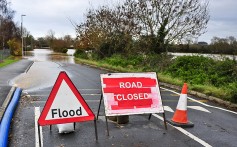
Cost of clean up after UK floods could hit £1 billion, insurers say
As rain continues to fall in Britain, more flooding is inevitable, and insurers say they may consider putting up premiums to cover the rise in payouts
The cost of clearing up in the UK after this winter’s floods and storms could rise to £1 billion (HK$12.7 billion) if rain continues to fall on water-logged ground and causes damage to more homes and businesses, an insurance expert has warned.
On Monday, multinational accountancy firm PricewaterhouseCoopers (PwC) revised up its forecast for the cost of flooding in December and January to £630 million, including a £500-million bill for the insurance industry. However, as the rain continued to fall in parts of the Southwest, and swelling rivers reached the outskirts of London, one insurer said the cost could easily increase.
“Many parts of the country are now saturated, which means further flooding is inevitable as the rain continues to fall. Parts of the Thames are now flooding too, affecting higher density areas,” said Justin Gott of insurance firm Hiscox. “If the rains continue into March or April, it’s not impossible for this to become a £1-billion event.”

James Rakow, an insurance partner at Deloitte, said he expected household insurance claims for flood damage to average £30,000 to £40,000 each.
While currently even on the highest estimates the bill is some way off the £3 billion the insurance industry is thought to have paid out following the floods that devastated huge swathes of the country in 2007, Rakow said insurers could consider putting up premiums to cover the cost.
“Claims from the current floods and storms are at a level where insurers will be looking at their finances to see what they need to do,” he said. “After the 2010 freeze we saw premiums rise by around 5 per cent to cover the cost.” That kind of rise would add between £10 and £15 to the average annual household insurance policy.
Graeme Trudgill, executive director of the British Insurance Brokers Association, said there was no indication yet that premiums would increase, but things could change when the total cost was known.
Householders in flood hit areas have been able to continue to buy cover under a deal between insurers and the government, but there has been no cap on the cost of cover. That is set to change next year, under an agreement called Flood Re. This will see a fund set up to provide payouts on properties insurers are unwilling to cover, with the industry paying in the premiums for high-risk properties, plus a levy of £180 million a year, or the equivalent of £10.50 a year on all household insurance policies. Those in flood-prone areas will pay up to £40 a year for the flood-insurance element of their cover, but the industry claims other householders will not see a price rise.

“If Flood Re is launched next year it should help keep premiums affordable for high risk flood areas,” said Rakow. He estimated that between the premiums and the levy, £300 million to £400 million a year will be paid into the fund for each of the next five years. “If the frequency of flood claims increases or more areas get classified as high-risk this could increase significantly in five to 10 years, potentially doubling.”
The British Property Federation has spoken out against exclusions in the proposals for Flood Re which will mean that leasehold and private rented properties will not qualify for the scheme, meaning owners will not have their annual premiums capped and may struggle to find insurance.
Dom Del Re, insurance catastrophe expert at PwC, said in the 2007 floods, 25 per cent of insurance claims were made by businesses. “Claims arising from business interruption could be a significant driver of the overall insured loss,” he said.
